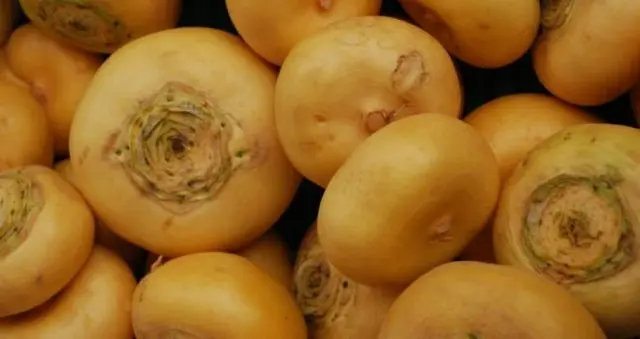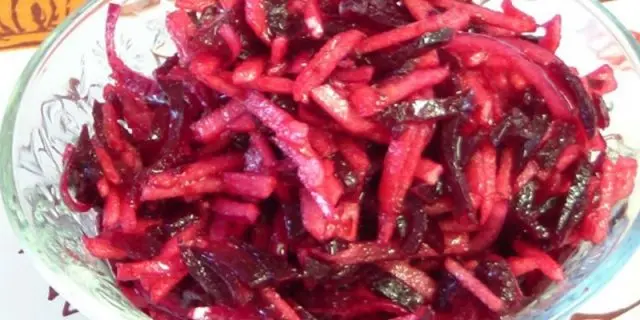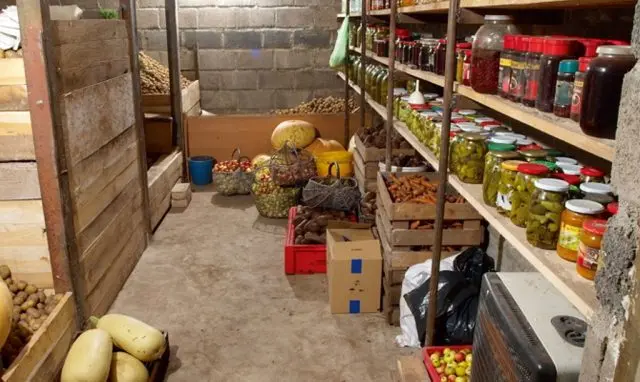Contents
Turnip is a useful, unpretentious root crop, which is often grown in the backyard. Grow early and late-ripening varieties. Early varieties are used to make salads, soups, it is added to pies and sourdough is made for kvass. Late-ripening ones have good keeping quality, but in order to preserve freshness, aroma and useful properties for a long time, you need to know how to properly store turnips at home.
Features of storing turnips for the winter
To enjoy a vegetable all year round, you need to know the cultivation technology and storage features of turnips. Storage considerations:
- turnips can be kept with other products, as it does not absorb odors;
- only vegetables that are smooth and without mechanical damage are subject to long-term storage;
- stored in a dark, cool room;
- when stored in a refrigerator, root crops are placed in plastic bags;
- turnips are best stored if the tops are cut at least 2/3 of the length;
- before storage, the vegetable is not washed, but only cleaned of the ground;
- to increase the shelf life, when stored in a box, it is better to wrap each root crop with a paper napkin or newspaper.
The best temperature for storing turnips for the winter is considered to be from 0 to + 3 ° C at an air humidity of 90%. In the basement and cellar, the root crop can be stored for about six months, in the refrigerator for no more than 1 month, at room temperature – 10-14 days.

How to properly prepare a turnip for storage
The main aspect for long-term storage is the correct harvesting and the chosen time:
- a ripe vegetable should be 5 cm in diameter and slightly rise above the ground;
- an unripe root crop can be eaten, but it is not suitable for long-term storage;
- an overripe turnip acquires a tough, low-juicy pulp.
If the brine is purchased in a store, then you need to make the right choice:
- A ripe vegetable should appear weighty, which means no voids.
- The root crop is yellow and white. When choosing a yellow variety, the flesh will be juicy and fleshy, but the dietary fibers are coarse. White varieties have a mild aroma, but the pulp has delicate, not hard fibers that are quickly absorbed by the body. White varieties are recommended for use in the preparation of baby food.
- When choosing a root crop, it is better to give preference to small fruits, since the flesh of large root crops has a bitter taste.
- A quality product should have a smooth, rot-free and mechanically damaged skin.
The vegetable is thoroughly washed before storage, dried under a canopy in the open air and immersed in paraffin or wax for 1-2 seconds. The wax shell will increase the shelf life up to 6 months. To prevent rotting of the top, turnips are dusted with chalk before storage.
There are several storage options and, if desired, you can choose the method you like the most. Each method differs in terms and location.
How to store turnips at home
If there is no cellar or basement, then you can store turnips for the winter at home. There are several ways:
- on the balcony;
- in a refrigerator;
- freezing;
- drying;
- conservation.
If a large crop is harvested, and there is no cellar on the plot, then it can be stored on the balcony. To do this, the turnip, cleaned of dirt, is laid out in a box covered with straw. Each layer is sprinkled with wet sawdust or sand. So that in winter it does not freeze, the box is wrapped with a blanket.
If the crop is small, then it can be stored in the refrigerator. Before storing the turnip, the tops are cut off and each root crop is wrapped in a paper napkin. Prepared turnips are laid out in plastic bags or plastic containers and put into the vegetable compartment.
Useful properties, aroma and juiciness of turnips do not lose during freezing, drying and conservation.
Before freezing, the product is washed, peeled and cut into small pieces. Prepared cubes are blanched for 2-3 minutes and immediately immersed in ice water. Dried cubes are laid out in bags or containers and put in the freezer. Thawed product cannot be re-frozen.

Dried turnip does not lose its aroma and beneficial properties for 6 months. You can dry it in the oven or using an electric dryer:
- The product is washed and peeled.
- The vegetable is cut into slices, the thickness of which should not be more than 5 mm.
- The slices are poured with boiling water and dried.
- The prepared turnip is placed in the oven or in an electric dryer.
- When drying in the oven, for better air circulation, the door should be ajar.
- Drying takes about 5 hours at a temperature of + 40 °C.
- The dried turnips are laid out in linen bags and cleaned in a dry, dark place.
Preservation for the winter
Only a fully ripened vegetable is suitable for fresh storage, without signs of rot and mechanical damage. If the process of decay has begun on the product, then it can be stored for the winter in canned, pickled or salted form.
Pickled turnips with apples
Required:
- water – 1 l;
- sugar – 250 g;
- salt – 50 g;
- apple cider vinegar – ½ tbsp.;
- cinnamon – 1 tsp;
- green apples and turnips – 1 kg each.
Preparation:
- Turnips, apples are washed and, alternating among themselves, put in a prepared container
- Sugar, salt, cinnamon are poured into the water and brought to a boil. At the end of cooking, vinegar is added to the marinade.
- The marinade is cooled to room temperature and prepared apples and turnips are poured.
- Preservation is cleaned in a warm place for pickling. To avoid the floating of the ingredients, a weight must be placed on the container.
- After 2 weeks, the blank is ready for use.
Canned turnip with beets
Products for harvesting:
- small turnip – 1 kg;
- beets – 1 pcs .;
- vinegar – 150 ml;
- garlic – 6 cloves;
- water – 1,5 l;
- salt – 5 tbsp l.
Preparation:
- Turnips are thoroughly washed, cut into slices, fall asleep 3 tbsp. l. salt and leave for 4 hours until the juice is released.
- At the end of salting, the slices are washed under running water and placed in sterile jars.
- Garlic, cut into small slices, and beets, cut into slices, are placed in jars.
- Bring water to a boil, add salt and vinegar.
- The resulting marinade is poured over vegetables and covered with nylon lids.

Salted turnip for the winter
For preparation you will need:
- turnip – 1 kg;
- coarse salt – 500 g;
- caraway seeds – 200 g;
- cabbage leaves – 5 pcs.
Method of preparation:
- Root crops are washed, peeled and cut into circles.
- In a separate bowl, mix salt and cumin.
- The resulting slices are placed in layers in a prepared container with a wide mouth, sprinkling each layer with a mixture of salt and cumin. Thus, stack all the vegetables.
- Vegetables are poured with boiled water to the very top, covered with cabbage leaves, a wooden circle and a load are installed.
- The blank is removed for 2 weeks in the refrigerator.
- After 2 weeks, the pickle is ready to eat.
How to store turnips in winter in the cellar
In the cellar, at a temperature of + 3 °C, turnips retain their freshness and aroma for six months. In this place it can be stored in several ways:
- In sand – vegetables are laid out in a box so that they do not touch each other, in 2-3 layers. Each layer is sprinkled with moistened sand. The topmost layer is covered with wet sawdust.
- in clay – each fruit is dipped into a clay mash. Dried turnips are laid out in prepared boxes or laid out in a single layer on rack shelves. The method is good because the clay crust protects the turnip from premature drying out and decay.
- in the ashes – each turnip is dusted with wood ash. The alkaline environment that forms after processing will protect it from premature decay. Prepared vegetables are laid out in wooden or paper boxes, pre-lined with polyethylene to preserve moisture.
To prevent mice from eating vegetables, elderberry branches are laid out next to the boxes. This plant has a pungent odor that repels rodents.

Tips and Tricks
If there is no cellar on the plot, then the collected turnips can be stored in ditches. Storage method:
- On a dry hill, a ditch is dug 70 cm deep.
- The bottom is covered with straw, on which the harvested crop is laid so that the vegetables do not touch each other. Each layer is sprinkled with dry sand.
- The moat is covered with sand so that the embankment is up to 30 cm high. So that rainwater does not lead to rotting of the root crop, longitudinal trenches are dug nearby.
- Before the start of frost, the mound is covered with rotted compost, straw or fallen leaves with a layer of 10-15 cm.
Turnip is a versatile and very healthy vegetable. From it you can cook a variety of dishes that will appeal to both adults and children. Uses of turnips in cooking:
- It is suitable for cooking vegetable caviar, it is stuffed with mushrooms.
- Add to salads. It goes well with sour apples, cabbage, pumpkin and carrots. The best dressing for a turnip salad is sour cream, unrefined butter, natural yogurt with the addition of citric acid or apple cider vinegar.
- The root crop is added to millet porridge, soups, and pie fillings.
Conclusion
You can store turnips in several ways, you only need to know the rules for collecting and storing vegetables. By listening to the advice of experienced gardeners, the root crop can be kept fresh and fragrant for six months.









